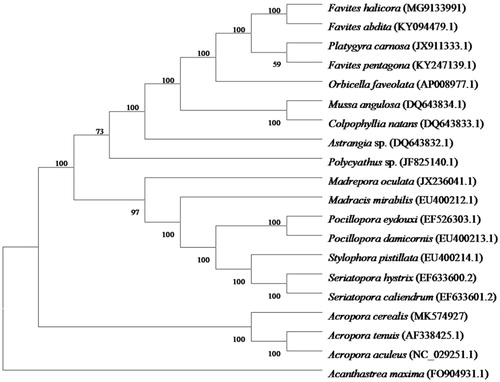Abstract
In this study, the complete mitogenome sequence of the Acropora cerealis (Acropora), has been sequenced by next-generation sequence method. The overall of A. cerealis mitogenome is 24.88% for A, 14.15% for C, 24.13% for G, and 36.84% for T, as well as 38.28% for low GC. The assembled mitogenome, consisting of 17,940 bp, has unique 13 protein-coding genes (PCGs), 2 transfer RNA genes and 2 ribosomal RNA genes. The complete mitogenome provides essential and important DNA molecular data for further phylogenetic and evolutionary analysis of stony coral phylogeny.
Keywords:
Acropora cerealis belongs to the family of Acropora. They distribute throughout the Indo-Pacific and South China Sea. The colonies of them are caespitose or corymbose. Colour usually uniform pale brown, cream or white, with purple, pink, blue, or cream branch tips (Veron and Stafford-Smith Citation2000). There are many related species of the genus are difficult in being separated. The first establishment of A. cerealis mitogenome is important for further evolutionary and phylogenetic analysis of stony coral.
Samples (voucher no. YM04) of A. cerealis were collected from Yang Meikeng sea area Daya Bay (22.5428°N, 114.5928°E) in Shenzhen, China. We used next-generation sequencing to perform whole genome sequencing according to the protocol (Niu et al. Citation2016).
The complete mitogenome of A. cerealis was 17,940 bp in size (GenBank MK574927) and its overall base composition is 24.88% for A, 14.15% for C, 24.13% for G, and 36.84% for T, as well as 38.28% for low GC. Circular form of complete mitogenome with about an average 51 × coverage.
The protein coding, rRNA and tRNA genes of A. cerealis were predicted by using DOGMA (Wyman et al. Citation2004) and MITOS (Bernt et al. Citation2013) tools and manually inspected. The complete mitogenome of A. cerealis includes unique 13 protein-coding genes (PCGs), 2 transfer RNA genes and 2 ribosomal RNA genes.
It is important to note that 6 PCGs started with ATG codon (NAD2, ATP6, COX2, ATP8, COX1, and CYTB), 2 with ATA codon (NAD6 and NAD5) and 5 with GTG codon (NAD4, COX3, NAD4L, NAD3, and NAD1). Seven of 13 PCGs are inferred to terminate with TAA codon (NAD2, NAD6, COX2, NAD4L, COX1, NAD1, and NAD5), 6 PCGs share the stop codon TAG (ATP6, NAD4, COX3, NAD3, ATP8, and CYTB). Among 13 PCGs, the longest one is COX1 gene (1602 bp), and the shortest is ATP8 gene (219 bp). The size of 12S rRNA and 16S rRNA are 1175 bp and 2258 bp, respectively.
To validate the phylogenetic position of A. cerealis, we used MEGA version 6.0 software Tempe, AZ, USA (Tamura et al. Citation2013) to construct a maximum-likelihood tree (with 1000 bootstrap replicates and Kimura 2-parameter model) containing complete mitogenomes of 20 species derived from 14 different families in Scleractinia. Acanthastrea maxima derived from Acanthastrea was used as outgroup for related to A. cerealis coral with high bootstrap value supported (). In conclusion, the complete mitogenome of A. cerealis deduced in this study provides essential and important DNA molecular data for further phylogenetic and evolutionary analysis for stony coral phylogeny.
Figure 1. Molecular phylogeny of Acropora cerealis and other related species in Scleractinia based on complete mitogenome. The complete mitogenome is downloaded from GenBank and phylogenetic tree is constructed by maximum-likelihood method with 1000 bootstrap. The gene’s accession number for tree construction is listed as follow: Favites halicora (MG9133991), Favites abdita (KY094479.1), Platygyra carnosa (JX911333.1), Favites pentagona (KY247139.1), Orbicella faveolata (AP008977.1), Mussa angulosa (DQ643834.1), Colpophyllia natans (DQ643833.1), Astrangia sp. (DQ643832.1), Polycyathus sp. (JF825140.1), Madrepora oculata (JX236041.1), Madracis mirabilis (EU400212.1), Pocillopora eydouxi (EF526303.1), Pocillopora damicornis (EU400213.1), Stylophora pistillata (EU400214.1), Seriatopora hystrix (EF633600.2), Seriatopora caliendrum (EF633601.2), Acropora cerealis (MK574927), Acropora tenuis (AF338425.1), Acropora aculeus (NC_029251.1), and Acanthastrea maxima (FO904931.1).

Disclosure statement
The authors report no conflicts of interest. The authors alone are responsible for the content and writing of the article.
Additional information
Funding
References
- Bernt M, Donath A, Juhling F, Externbrink F, Florentz C, Fritzsch G, Putz J, Middendorf M, Stadler PF. 2013. MITOS: improved de novo metazoan mitochondrial genome annotation. Mol Phylogenet Evol. 69:313–319.
- Niu WT, Lin RC, Shi XF, Chen CH, Shen KN, Hsiao CD. 2016. Next generation sequencing yields the complete mitogenome of massive coral, Porites lutea (Cnidaria: Poritidae). Mitochondr DNA Part B. 1:8–9.
- Tamura K, Stecher G, Peterson D, Filipski A, Kumar S. 2013. MEGA6: molecular evolutionary genetics analysis version 6.0. Mol Biol Evol. 30:2725–2729.
- Veron JEN, Stafford-Smith M. 2000. Corals of the world. Crawley, Australia: Australian Institute of Marine Science.
- Wyman SK, Jansen RK, Boore JL. 2004. Automatic annotation of organellar genomes with DOGMA. Bioinformatics. 20:3252–3255.
